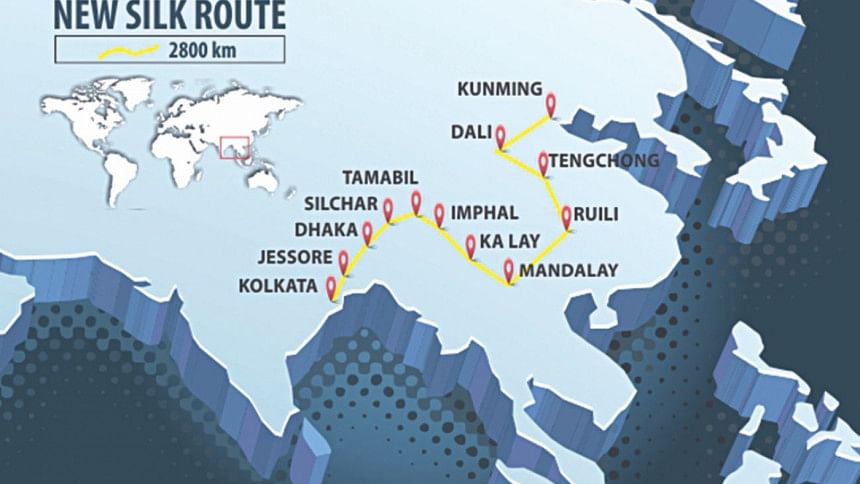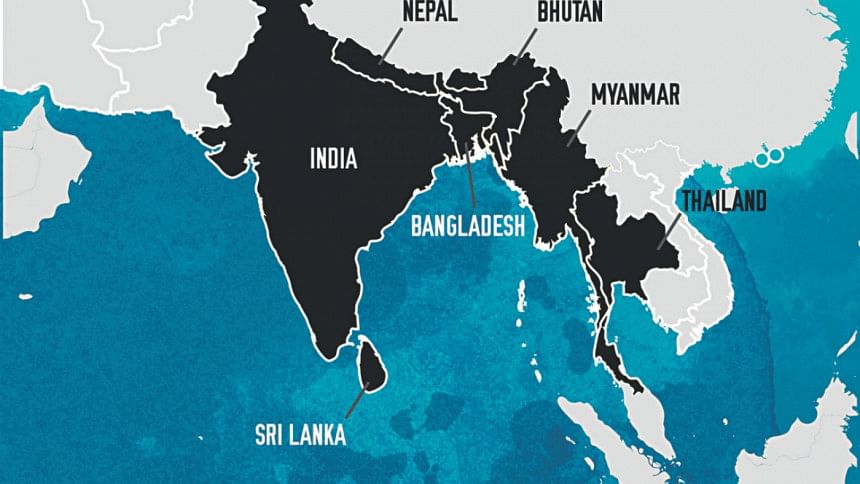Bangladesh: Gateway to three civilisations

Bangladesh is a country uniquely located in the world. Like a hem it geographically stiches three mega civilisations and three mega growth centres in Asia. To the west of Bangladesh lies India. To the north it is China and to the east are the countries of ASEAN. Together these three civilisations according to the IMF in 2014 account for 32.6 trillion dollars GDP (China 18.6 trillion + India 7.4 trillion + ASEAN 6.6 trillion) of 108 trillion world GDP. Therein lies the birthplace of the world's three great religions and philosophies: Buddhism, Hinduism and Confucianism. It is the region where 45% of the world's population live and which is one the largest agglomeration of consumer products of the world. Bangladesh located in the centre of this region itself has 159 million people and has a GDP of USD 174 billion. Around Bangladesh throughout history the bulk of scientific discoveries and innovation had taken place. Even today the race to register the largest number of patents in competition with the USA and European countries are taking place from here. Some of the world's unique tourist spots lies in this general region. The tallest mountain peaks, the mega glaciers and some of the oldest historical relics and the largest rivers and deltas are located here. The most diverse and delectable cuisine can be found in and around Bangladesh.
Yet Bangladesh had remained a poverty stricken land and a backwater. But it has some of the most productive agricultural land. The country is a paradox wrapped in a riddle. Our history has been merciless. One thousand five hundred to two thousand years ago we had travellers coming from China to the territory of what is now Bangladesh. They came to learn about Buddhism and gain knowledge on various subjects. In those days they came here to learn at the feet of our sages in 35 Buddhist monasteries and centres of learning. They went back to their countries, established Buddhist monasteries and set up learning centres. Teachers and priests from Bangladesh also travelled to neighbouring countries by foot. Notable among them was Atish Dipanker who went from Dhaka to Tibet and taught about Buddhism. The type of Buddhism in Tibet is similar to what Buddhism is in Bangladesh. It is curious that Bangladeshis in several ways were purveyors of knowledge in this part of the known world.
Then what happened? Migration of people from west Asia and India and later from far away UK in waves not only settled in this land and overwhelmed the way of life. The rich accumulation of knowledge was dissipated and the sages of this land died and were forgotten. The inheritance was lost.

Fast forward to the twentieth century when Bangladesh, through a bloody war of independence, got back its present self. It is now that scholars are sifting through the sands of time to see what was left behind by the original inhabitants. The new generation is starting to begin a new journey in the world to build its own future. Planners and political leaders of Bangladesh after centuries are realising that connectivity of Bangladesh with its neighbouring countries will not only help open up the past with the present. It would also lead to trade and commerce as well as to faster accumulation of knowledge and greater industrialisation of the region. New markets are likely to be created with large investments leading to greater wealth accumulation.
The geographic location of Bangladesh is therefore a boon and not a bane. The people of this fecund region has to build connectivity not only by air but by water and land to access the entrepreneurship and the skill to build huge swaths of production and consumption and leisure. With the award of huge patches of sea and coastline to Bangladesh in the Bay of Bengal, the country is now able to connect her territories to neighbouring Indian mega cities and industrial belts in India and next door Myanmar. Bangladesh is also connecting many of its small cities and industrial belts with those in these countries. Thus a network of roads and railway lines will be criss-crossing Bangladesh to reach out to points in India, Nepal, Bhutan and Myanmar.
At a regional level Bangladesh is keen to connect parts of the country with south west China as well as South east Asia. In the coming twenty-five years Bangladesh would be in an unviable position to buckle together this huge land with their resource in a seamless area which would be the envy of the world.
For a comprehensive picture of regional connectivity let us go back in history. In the past when the territory of Bangladesh was a part of the British administered India, it was possible to travel to the west by road and rail from this part to all parts of present day India as well as to Pakistan. There was road and rail connections to now north east India (like Assam etc.). Although no connectivity by road or rail was available to travel to the east such as Myanmar or to other parts of south east Asia there remained a disconnect here. This was true also for travel to Nepal and Bhutan. In fact, there was general connectivity to India and Pakistan by rail and sparse roads. However, from 1958 connectivity to the west of Bangladesh was gradually snapped in stages. The 1965 war between India and the then Pakistan saw the sealing of the territory that now comprises Bangladesh (then known as East Pakistan). Thus by 1966 the territory that is now Bangladesh was sealed off on all sides from India. Later when insurgencies spouted in both sides—east and west Bangladesh, travel became restricted within the territory of Bangladesh. Only by air and sparingly by sea could the citizen of what is now independent India and present Bangladesh have any physical interaction.
However, in stages, over a period from 1972, connectivity began from Kolkata in West Bengal (India) to Dhaka (capital of Bangladesh). Some border points along Bangladesh and India were sparingly opened by road between the two countries. With the second coming of Prime Minister Sheikh Hasina to power in Bangladesh there is a relaxation in connectivity between the two countries. But the gate of connectivity with India has really opened with the visit of Prime Minister Hasina to Delhi in 2010 and later the return visit of Indian Prime Minister Modi to Dhaka in 2015. During these visits some agreements protocols and MOU's had been signed. In the meantime, railway and bus connectivity has become operational between the two neighbouring countries. Another major step was taken in June 2015 when motor connectivity agreement was signed between Bangladesh and India, Nepal and Bhutan. With this and easing of visa restrictions, the citizens of these four countries in future will be able to commute freely for business and pleasure.
One of the bane to inter-country connectivity is the condition of Bangladesh railways. Not only the rolling stock in Bangladesh as well as railway lines and signalling system are outdated and rickety. Rail connection between India and Bangladesh are almost non-existent and ancient. They need immediate up gradation.
Then there is the matter of upgrading roads, especially highways within Bangladesh. Most of Bangladesh inter city roads are not built to take the loads of multi axle vehicles from India, Nepal and Bhutan. Without modern roads these countries cannot use Mongla and Chittagong ports in Bangladesh. Thus there is need to build new highways and massive upgrading of the existing ones. This will require huge investment of hundreds of millions of dollars. Highway management and services also need to be greatly improved. The existing highways and roads cannot cater to traffic that will be generated between and among the four countries in the next four to six years. An immediate investment of two to three billion dollars can begin to facilitate seamless cross border movement of vehicles. At least USD 20 million would be needed for improvement of Tamabil, Akhura, Sitakundu and Benapole land ports. Future investment of another USD 35 million will be needed for improving the efficiency of Chittagong port. Once the internal road network is modernised and rationalised, can Bangladesh start connecting in right earnest with those Indian neighbouring states.
The difficult hurdle to cross is to establish road connectivity in the east with Myanmar and with China. There are three mountain ranges in Myanmar close to Bangladesh border which blocks road building to connect from Chittagong to the main highways within Myanmar which run from the northern border of that country close to south China and move south to Yangoon. If roads can be built from Gundum in Bangladesh to Sittwe in Myanmar, then it would be easy to connect to the highways within Myanmar. In that case it would be possible for travellers from Chittagong to crossover to Myanmar and travel north to Kunming in China. Once that happens then Bangladesh could be connected not only to China but also to Korea. This is now a dream for us but it could be a reality in the next 20 years.
Economic prospects for Bangladesh become limitless if we are able to connect with India, Bhutan, Nepal, north east India, Myanmar and China. We could rival the mega growth centres of the world like North America, Europe and south east Asia. All we need is a peaceful and seamless growth in Bangladesh for the next 25 years. Bangladesh today is a member of SAARC, and of BIMSTEC. We should join Shanghai Cooperation Council. Policy coordination with neighbouring countries would be easy and seamless.
Bangladesh has two sea ports in the Bay of Bengal. Connectivity is being established directly from five ports on the eastern sea board of India. We must connect with the ports of Myanmar and Thailand too. Regular shipping should be established between the ports of these countries. In Bangladesh we must start with building a deep sea port as soon as possible. We must also upgrade the capacity of existing sea ports and start planning to establish three more sea ports to receive large ships from neighbouring countries. Do not forget that Bangladesh has a large hinterland which includes Nepal, Bhutan. Northeast India and even northern Myanmar and southern China. In fact, Bangladesh is at the cusp of being one of the biggest transport hub in Asia. How can we afford to lose this great natural advantage available to us? Bangladesh is not destined to be poor. We must look forward to lead this part of the world. It is not a pipe dream. It can be a reality if we play our political and economic cards right for at least the next decade.
The writer is a former Ambassador and was Ambassador to China.
E-Mail: [email protected]

 For all latest news, follow The Daily Star's Google News channel.
For all latest news, follow The Daily Star's Google News channel. 



Comments